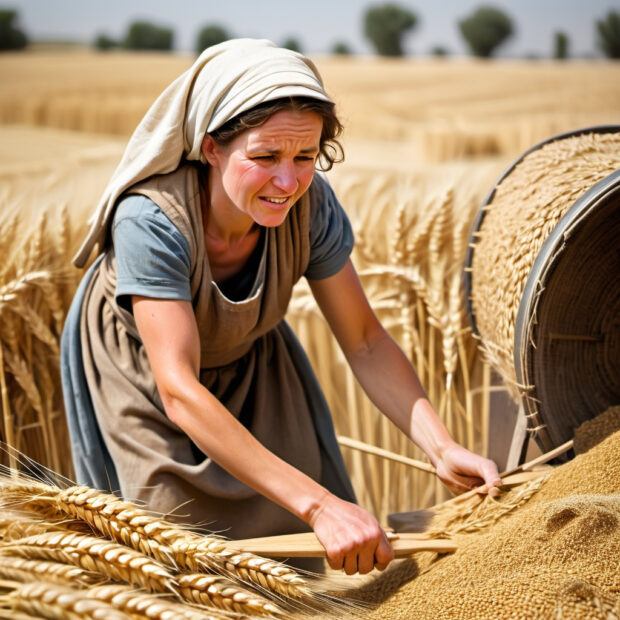The Book of Ruth, though brief with only four chapters, presents one of the most heartwarming and inspiring stories in the Bible. It unfolds against a backdrop of loss, loyalty, and ultimate redemption, showcasing how God’s providence can turn sorrow into joy. The narrative begins with hardship but ends in hope, revealing the important themes of faith, family, and divine intervention.
Ruth 1: The Story Begins with Tragedy and Loyalty
The first chapter of Ruth opens during the time of the judges, a period marked by chaos and instability in Israel. A famine strikes Bethlehem, forcing Elimelech, his wife Naomi, and their two sons, Mahlon and Chilion, to leave their home and settle in Moab, a foreign land.
However, tragedy strikes Naomi. First, her husband Elimelech dies, leaving her a widow. Her two sons marry Moabite women, Orpah and Ruth, but after about ten years, both sons also die, leaving Naomi without a husband or children.
In her grief, Naomi decides to return to Bethlehem after hearing that the Lord had visited His people and provided them with food. She urges her daughters-in-law, Orpah and Ruth, to return to their families in Moab and find new husbands. Though both initially resist, Orpah eventually chooses to return home. Ruth, however, refuses to leave Naomi. Her words express her deep loyalty and faith:
“Entreat me not to leave thee, or to return from following after thee: for whither thou goest, I will go; and where thou lodgest, I will lodge: thy people shall be my people, and thy God my God” (Ruth 1:16, KJV).
Ruth’s devotion leads her to accompany Naomi back to Bethlehem, signaling the beginning of a profound journey.
Ruth 2: Ruth’s Humility and Boaz’s Kindness
Chapter 2 introduces the character of Boaz, a wealthy and kind relative of Elimelech. To support herself and Naomi, Ruth goes to glean in the fields, gathering leftover grain behind the harvesters. It is during this time that she enters Boaz’s field without knowing he is related to Naomi’s late husband.
Boaz soon notices Ruth and inquires about her. Upon learning of her loyalty to Naomi, he treats her with exceptional kindness. Boaz instructs his workers to leave extra grain for Ruth and allows her to drink from their water supply. He acknowledges Ruth’s faithfulness to Naomi, saying:
“The Lord recompense thy work, and a full reward be given thee of the Lord God of Israel, under whose wings thou art come to trust” (Ruth 2:12, KJV).
Ruth returns home to Naomi, laden with grain, and shares the day’s events. Naomi is overjoyed when she learns that Boaz, a close relative, had been so kind to Ruth. She reveals that Boaz is a kinsman-redeemer, a term referring to a relative who has the obligation to help family members in need, including marrying a widow to preserve the family line.
Ruth 3: The Proposal at the Threshing Floor
In chapter 3, Naomi devises a bold plan to secure Ruth’s future. She instructs Ruth to go to the threshing floor at night, where Boaz will be winnowing barley. Naomi tells Ruth to wait until Boaz has eaten and lain down to sleep, then to uncover his feet and lie down at his feet—a symbolic act of humility and a request for protection.
Ruth follows Naomi’s instructions and, in the middle of the night, Boaz awakens to find Ruth at his feet. When he asks who she is, Ruth responds with a marriage proposal of sorts, asking Boaz to “spread therefore thy skirt over thine handmaid; for thou art a near kinsman” (Ruth 3:9, KJV). This act signifies Ruth’s request for Boaz to take her as his wife and fulfill the role of the kinsman-redeemer.
Boaz is moved by Ruth’s request, noting that she is a virtuous woman. He agrees to marry her but mentions that there is another man who is a closer relative and has the first right to act as the kinsman-redeemer. Boaz promises to settle the matter the next day.
Ruth 4: Redemption and Restoration
The final chapter, Ruth 4, brings the story to a joyful conclusion. Boaz goes to the city gate, where legal matters are discussed, and calls the closer relative to discuss the redemption of Elimelech’s property and Ruth’s hand in marriage. When Boaz explains that marrying Ruth is part of the arrangement, the man declines, fearing it will jeopardize his own inheritance.
With the other kinsman out of the picture, Boaz formally redeems Elimelech’s property and takes Ruth as his wife. Their union is blessed, and Ruth gives birth to a son named Obed, who becomes the grandfather of King David, the great king of Israel.
The women of Bethlehem rejoice with Naomi, recognizing that her life has been restored. Once empty and bitter, Naomi is now filled with joy, as she nurses her grandson and sees her family’s legacy continue.
Conclusion: The Legacy of Ruth
The Book of Ruth is a powerful story of faith, redemption, and divine providence. Ruth’s loyalty to Naomi, Boaz’s kindness, and the ultimate restoration of Naomi’s family all reflect God’s care for His people, even during times of personal hardship.
Ruth’s journey from Moab to Bethlehem symbolizes the journey of faith, where individuals leave behind their old lives to embrace God’s plan. Her story also shows how God’s grace extends beyond the boundaries of Israel, as Ruth, a Moabite, becomes an ancestor of Jesus Christ.
The Book of Ruth stands as a reminder that even in the darkest times, God’s hand is at work, guiding His people toward redemption and fulfillment of His promises.
